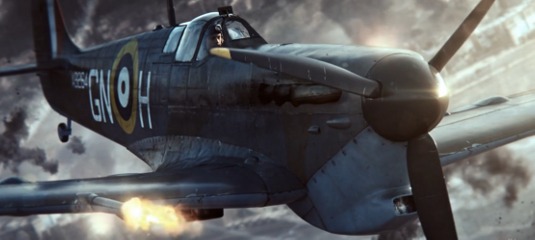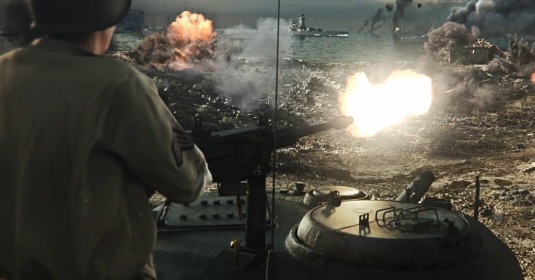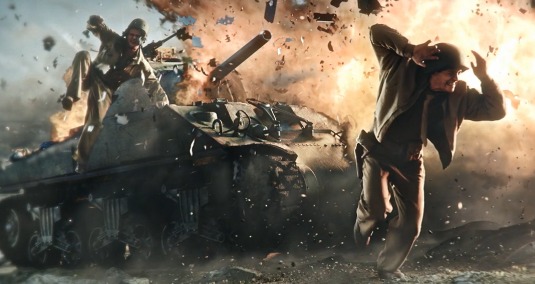How RealtimeUK gave War Thunder some cinematic magic
An epic wargame deserves an epic trailer, and that's what RealtimeUK provided for War Thunder. We find out how they did it.
To promote its massively multiplayer World War II combat sim, War Thunder, Gaigin Entertainment brought in creative CG studio RealtimeUK to make a suitably impressive trailer. The result was War Thunder Heroes, an epic mix of extreme slow-motion action and enormous explosions, guaranteed to get gamers' pulses racing. 3D World spoke to RealtimeUK's Dave Cullinane to find out what went on behind the scenes.
What software did you use to create War Thunder Heroes?
For this piece, our team used a number of software solutions including 3DS Max, V-Ray, Houdini, Hair Farm, Krakatowa, Ray Fire, Particle flow and FumeFX which were all plugged into our pipeline. We're fortunate in that RealtimeUK have a large team made up of talented artists that specialise in using these particular packages as they were easily the best solutions for what we wanted to achieve.
How long did it take you to create the cinematic?
The production itself took over two and a half months to complete. However, as were also responsible for producing the creative from the client's own brief, a significant amount of time was spent in pre-production nailing the final concept for the client. Our team evolved a series of ideas into a solution that everyone was truly excited by.

More and more, as we continue to work with global clients that may not have English as their first language, our rigorous pre-production pipeline is proving to essential in communicating ideas effectively. Taking the time to produce a detailed 3D animatic and concept artwork and planning everything down to the minutest detail makes for a much smoother and effective production time.
- Learn the secrets of game cinematic techniques in the new issue of 3D World, on sale now!
Did you use any unusual or notable techniques?
Yes; as the majority of the piece is in extreme slo-mo, the production had many technical challenges, as much of what we wanted to convey was under much greater scrutiny and required high levels of detail.
Houdini was used to produce the complex water simulations, many of which had tens of millions of particles. With something as complex as this, its the only option as base tools would never have been able to have achieved this in a realistic time frame. We used Houdini's Flip and Water solvers and used a custom velocity field to add more detail to the simulations. All of this data was then exported into our current pipeline tools, which were then rendered in V-Ray and Krakatoa.

What did you most enjoy about creating the cinematic?
This particular cinematic was particularly enjoyable to create because it offered us a chance to show our skills in creating lifelike believable characters that demand an emotional response from the viewer. Although we're perhaps most famously known for our vehicle trailers, this cinematic gave us the opportunity to stretch our wings further and put into practice the extensive amount of research and development we've been conducting in producing lifelike characters. It also gave us the opportunity to turn up the dial to eleven in terms of the quality and attention to detail as slo-mo is very unforgiving and there's no way of hiding from authenticity. This is just the beginning for us – we're already working on projects that develop this much further.
How did you get the characters looking so realistic?
All of the characters were scanned using advanced photogrammetry techniques which we helped our supplier develop especially for this production. The characters were scanned in costume, with each one carefully selected so that they had an 'everyman' quality rather than some kind of 'airbrushed' version of reality. Again, pre-production proved really useful as we used extensive concepts to convey to the client the exact expressions that we wanted each of the actors to convey on the day of the shoot. Ten-24 were fundamental in scanning the actors using a 80 camera rig set up. From the supplied data, we received one character mesh and one texture, so there was further work needed to be done by our guys in the studio to ensure that it was suitable for production. Once all this was done, the V-Ray sub-surface 2 shader was used to get an accurate representation of Skin. Although this process is a lot of work, it was fundamental in trying to achieve an emotional response from the viewer and something that might never have been achieved had we modelled the characters from scratch.

Is it more important than ever to keep pushing what is possible in cinematics?
Absolutely! Especially in Games where triple-A productions demand bigger and better 'Wow!' factors – the clients simply demand it. RealtimeUK have built a solid reputation over 17 years in pushing the fidelity as far as possible. We're really proud with what we've achieved our raison d'être at RealtimeUK is to continually push the envelope and increase the quality and creativity of the work we produce. Clients appreciate our enthusiasm for this and its why we continue to invest in our technologies, pipeline and staff.
There would be no benefit in resting on our laurels – neither for us or our clients!
How are developments in technology likely to change the way you work or expectations of what can be achieved?
It's still early days on what type of content that we can expect to see in the long term on these new platforms, although its certain to say already that visual expectation and fidelity will continue to climb. Obviously this is great for us as we thrive on detail in our cinematics. I think the biggest sea change we can expect to see will be that projects are becoming bigger and much more technically demanding. To address this we've been recruiting extensively and are investing in our pipeline to ensure that we can produce the highest levels of quality in as short a turnaround as possible. We are also starting to explore how our services can be incorporated into next-gen game engines themselves.
Liked this? Read these!
- The best 3D movies of 2013
- Discover what's next for Augmented Reality
- Maya tutorials: awesome projects to try today
Seen an amazing game cinematic? Tell us in the comments!

Thank you for reading 5 articles this month* Join now for unlimited access
Enjoy your first month for just £1 / $1 / €1
*Read 5 free articles per month without a subscription

Join now for unlimited access
Try first month for just £1 / $1 / €1
Get the Creative Bloq Newsletter
Daily design news, reviews, how-tos and more, as picked by the editors.

The Creative Bloq team is made up of a group of art and design enthusiasts, and has changed and evolved since Creative Bloq began back in 2012. The current website team consists of eight full-time members of staff: Editor Georgia Coggan, Deputy Editor Rosie Hilder, Ecommerce Editor Beren Neale, Senior News Editor Daniel Piper, Editor, Digital Art and 3D Ian Dean, Tech Reviews Editor Erlingur Einarsson, Ecommerce Writer Beth Nicholls and Staff Writer Natalie Fear, as well as a roster of freelancers from around the world. The ImagineFX magazine team also pitch in, ensuring that content from leading digital art publication ImagineFX is represented on Creative Bloq.
